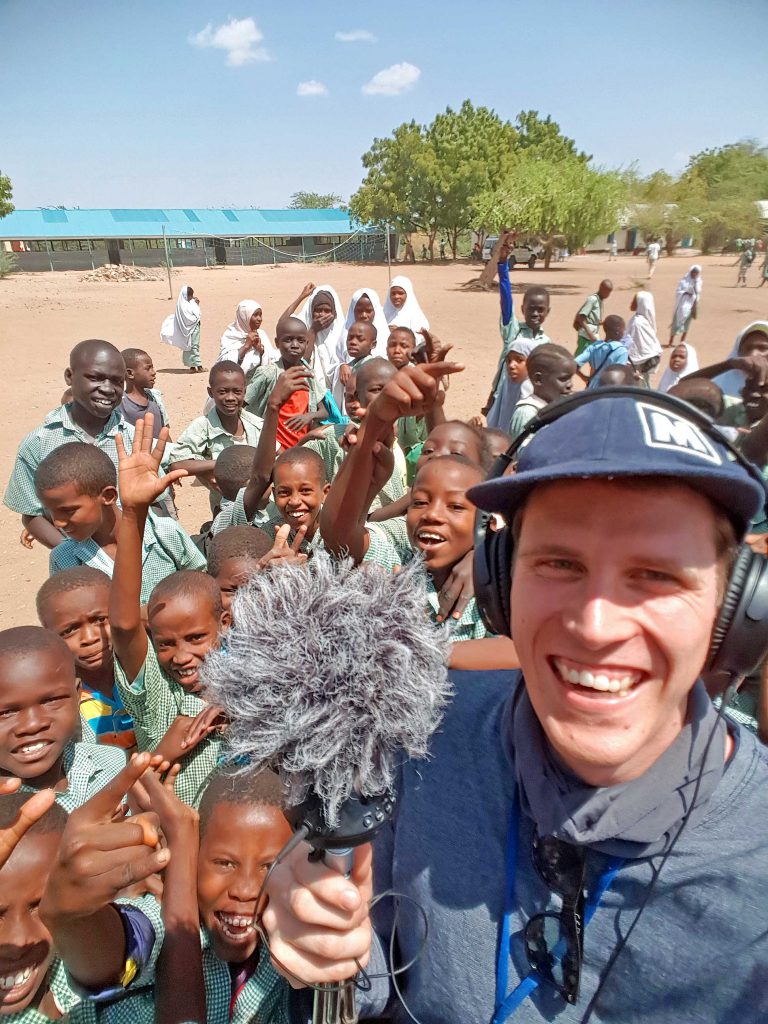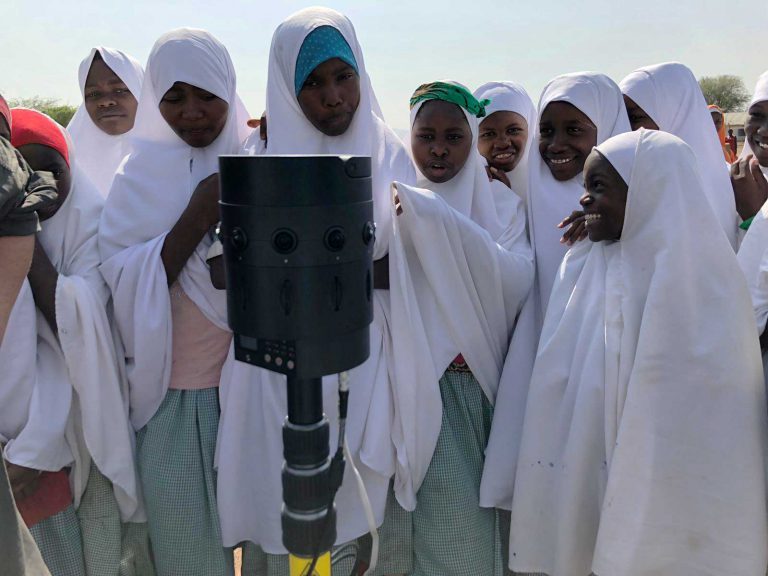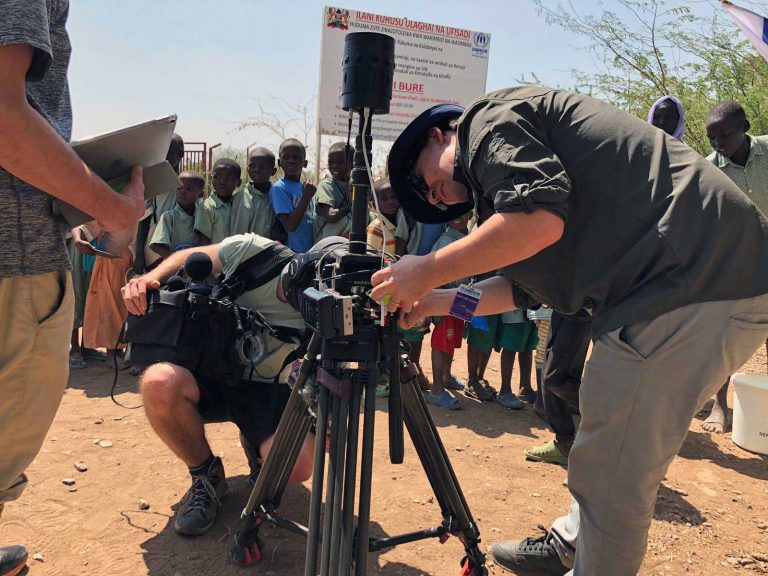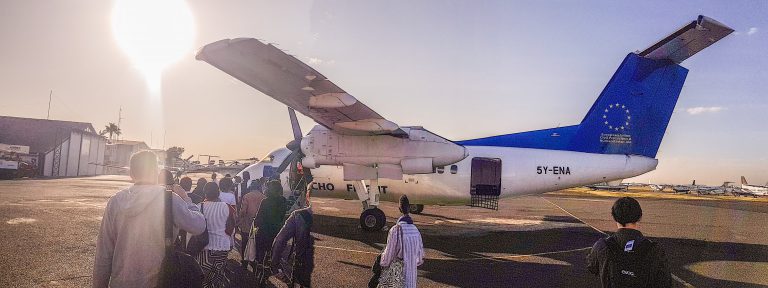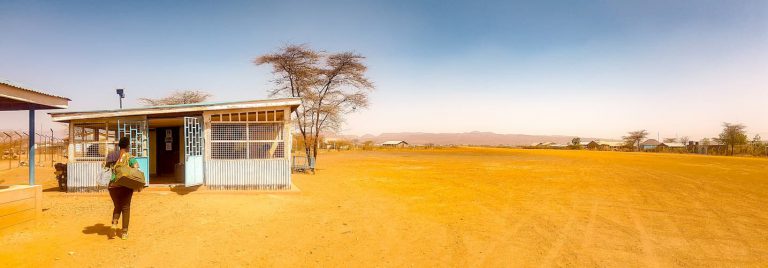
#EUsavesLives 2 Kenya (3D Sound Demo 360 Video)
The #EUsavesLives project is an impressive example of the power of 3D Sound combined with 360° video to connect and create immersive experiences. The second phase of this successful project, which had already been implemented in countries like Bangladesh, Denmark, and Belgium, took us to Kenya, specifically to the Kakuma refugee camp.
Using 3D Sound and modern technologies, a 360° video was produced, allowing viewers to listen and closely experience the daily life of a 13-year-old refugee boy from Somalia. The immersive audio quality, achieved through the use of Ambisonics microphones and high-end wireless systems, not only conveys the reality but also deepens the emotional connection to the story.
VR goes Education
In the refugee camp Cox’s Bazaar (Bangladesh) we had already highlighted the issue of humanitarian aid. So now we focused on education and schooling. What is the everyday life of a 13-year-old refugee boy who was torn from his life in Somalia? We wanted to illuminate this question with a documentary 360° video.
So we accompanied the boy as a small team of four. A 360° camera man, VR director, camera assistant and myself as a sound engineer. With a Z CAM V1, we could make high quality stereoscopic 360° video recordings. While I recorded the immersive 3D audio sound with high-end wireless radio and Ambisonics microphones.

360° Video Production
The production conditions were extremely difficult. The three flights alone during the journey to the 40°C hot camp were quite a travel. But there were also a number of challenges on-site. But the local people were always cooperative. Even people who live in tin huts and have almost no possessions welcomed us friendly. These are experiences that I appreciate very much during my work and that always opens my eyes and ears.
This has resulted in a sustainable VR experience that doesn’t press too hard on the tear gland. Therefore, the medium 360-degree video is still fascinating for me. It conveys a realistic image of the fates on site. In addition, the all-round view, but lacking interactivity, gives an observer’s role and thus feels certain helplessness.

Marketing Campaign
As in the previous year, a roadshow was organized to share these experiences with as many people as possible. This form of immersive storytelling can also be used for marketing purposes. In addition, the image of DG ECHO and humanitarian aid operations was specifically enhanced.
The app development was done by VRdirect with a customized Unity application. Known for their virtual reality platform, they offer a simple solution for creating and publishing 360VR content. For the 360° sound we used the multichannel audio format tbe (two big ears). In addition to the spatial 3D sound, we also used interactive game audio assets. For example for UI (User Interface) elements such as clicking, hovering, selecting and confirmation sounds.
But the new clip was also a success on social media: Currently, the above video on Facebook 360 counts almost 5 million views, 30,000 reactions, and 1000 comments.
Here are some making-of pictures of the 360VR production. They raised awareness of crises on social media platforms like Facebook 360 or YouTube.
3D Sound Demo for VR
In a time when Spatial Audio and 3D Sound are increasingly being used in music, films, and on streaming platforms like Netflix, this project demonstrates the powerful potential of these technologies in education and humanitarian efforts.
It highlights the difference between traditional stereo sound and immersive 3D spatial audio experiences, which enhance the sense of presence and make the story more tangible for the audience.
What is 3D Sound, and how does it differ from Stereo Sound?
3D Sound or 3D Audio is an audio technology that enables sound to be perceived from all directions, similar to how it is experienced in the real world. In contrast to traditional stereo sound, where audio is delivered through two channels—left and right—3D Audio provides a more immersive soundscape. Sounds can come from above, below, in front, behind, and from the sides, greatly expanding the immersive listening experience.
Definition of 3D Audio and Spatial Audio Compared to Stereo Sound
3D Audio significantly differs from stereo sound, as it creates a more comprehensive spatial sound image. While stereo is limited to two channels, 3D Audio uses technologies like Ambisonics and Spatial Audio to place sounds in a three-dimensional space.
Spatial Audio is particularly used on platforms like Apple and Sony, with devices such as AirPods Max or Sony headphones, to precisely position sound within a room or screen. Although similar to the audio experience in VR, it serves different purposes, such as enhancing music and films.
How Head Tracking and Ambisonics Expand the Sound Field
One of the key technologies that make 3D Audio so effective is head tracking. This function ensures that the sound changes dynamically as the listener’s head moves, creating a more realistic and dynamic sound experience. Ambisonics further enhances the sound field by allowing even more precise placement of sounds in space, coming from the speakers in all directions.
The combination of head tracking and Ambisonics amplifies the immersive experience of songs, making listeners feel as though they are truly in the midst of the action—especially important for 360° videos and VR experiences.
The Role of Dolby Atmos and Reality Audio in Modern Audio Systems
Dolby Atmos and Reality Audio are leading technologies for mehr erfahren experiences in areas like home cinema, music, and streaming platforms like Netflix. They provide precise sound placement within the room, creating a room with an impressive surround sound experience.
However, despite what one might initially hear or think, both Dolby Atmos and Reality Audio are not suited for use in VR or 360° videos. The reason is that these technologies are designed for fixed environments and do not account for head movement or changes in perspective. For VR and 360° video, technologies like Ambisonics and true 3D Audio formats are more suitable, as they allow for dynamic interaction between sound and movement.
In modern audio systems, Dolby Atmos and Reality Audio still offer exceptional experiences in traditional surround sound applications, but for fully immersive VR experiences, specialized formats are required to further optimize the 3D Audio experience.
The Technology Behind the 360° Video and 3D Audio Production
Creating an immersive 360° video with 3D Audio requires precise and advanced technologies to realistically capture the spatial depth both visually and acoustically. For the production of the #EUsavesLives project in Kenya, exceptionally high-quality recording equipment and innovative techniques were used to achieve the best possible natural sound and image quality.
Using Ambisonics Microphones and High-End Wireless Systems
Ambisonics is one of the leading technologies for capturing and reproducing sound in three dimensions. It captures sound from all directions and allows for the precise spatial reconstruction of the sound field, which is essential in 360° video productions.
In the challenging environment of the Kakuma refugee camp, the quality of the audio recording was crucial. By using high-end wireless systems and headphones, we could capture clear and reliable sound over long distances, which was essential in such an open and busy setting.
Recording and Playback Technologies for Surround Sound and 3D Audio
For playback, special 3D Audio formats were used to ensure that sound was reproduced optimally on different devices. These technologies allowed the artists and the audience to experience sound as if they were physically present, strengthening the connection to the scenes shown and creating a sense of being fully immersed in the story.
Integration into Apps Like YouTube and Facebook 360
A key part of the success, engagement and reach of the #EUsavesLives project was its integration into platforms like YouTube and Facebook 360. Both platforms support 360° videos and 3D Sound, making the immersive experience accessible to a wide audience.
By publishing the content on YouTube VR and Facebook 360, millions of people worldwide were able to experience the 360° game videos with 3D Sound. Users could easily interact with the videos on their devices, navigating through the dynamic soundscapes. These platforms supported both Spatial Audio playback and head tracking, adjusting the sound based on the user’s head movements.
Immersive Audio Experiences in VR
3D Audio plays an indispensable role in the production of 360° videos, as it guides viewers through the storytelling process. In contrast to traditional formats, 3D Sound allows sound to be positioned in space, helping viewers intuitively know where to look. By placing sounds precisely, scenes are highlighted both visually and acoustically, making the story more effective and immersive.
In VR experiences, the use of 3D Audio is crucial because it enhances the feeling of being in the middle of the action. In 360° videos, viewers often don’t know which direction to look, but precise audio cues guide them instinctively. This not only creates clearer storytelling but also fosters a deeper emotional connection to join the narrative.
Conclusion: The magic of 3D Sound Demos in VR
3D Sound and Spatial Audio are becoming increasingly important in Virtual Reality. They offer immersive audio experiences that guide listeners intuitively and immerse them deeply in the story. In games, films, and music, technologies like Dolby Atmos and Reality Audio bring new dimensions of listening. With headphones like the AirPods Max or Sony headphones, users can enjoy a precise distribution of sound that goes far beyond traditional stereo sound.
Though challenges arise with playback on different devices like the iPhone or AV receivers, they can usually be addressed by adjusting the settings to achieve optimal results. 3D Sound will also play a significant role in marketing campaigns, emotionally with customers, enhancing stories and presenting products immersively.
In the future, 3D Audio will revolutionize the media experience in TV, films, and streaming services, setting new standards for immersion in both the virtual and real worlds.
Contact me now for a free, no-obligation consultation!
